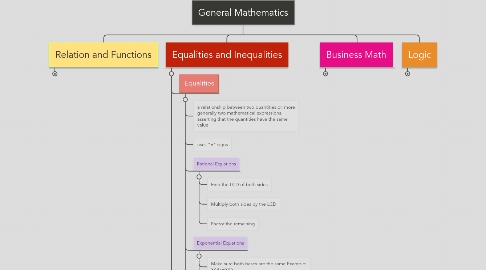
1. Relation and Functions
1.1. Relation
1.1.1. A relation is simply a set of ordered pairs.
1.2. Function
1.2.1. A function is a set of ordered pairs in which each x-element has only ONE y-element associated with it.
1.3. Domain and Range
1.3.1. Domain: Set of values used for inputs
1.3.1.1. Domain in a Polynomial function is (-∞,∞)
1.3.1.2. Domain in a radical function:
1.3.1.2.1. If radical expression is even then the denominator is not equal to 0
1.3.1.2.2. If the radical expression is odd then the domain will be (-∞,∞)
1.3.1.3. Domain in a rational expression has one restriction and the denominator is not equal to 0
1.3.2. Range: Set of values used for outputs
2. Equalities and Inequalities
2.1. Equalities
2.1.1. a relationship between two quantities or, more generally two mathematical expressions, asserting that the quantities have the same value
2.1.2. uses "=" signs
2.1.3. Rational Equations
2.1.3.1. Find the LCD of both sides
2.1.3.2. Multiply both sides by the LCD
2.1.3.3. Factor the remaining
2.1.4. Exponential Equations
2.1.4.1. Make sure both bases are the same Example: 3^4x=3^5
2.1.4.2. Cancel out the bases Example: 4x=5
2.1.4.3. Find X
2.1.5. Logarithmic Functions
2.1.5.1. Isolate the logarithmic term before you convert the logarithmic equation to an exponential equation.
2.1.5.2. Convert the logarithmic equation to an exponential equation: If no base is indicated, it means the base of the logarithm is 10.
2.1.5.3. Solve for X
2.2. Inequalities
2.2.1. An inequality says that two values are not equal.
2.2.2. uses ">, <, ≥, ≤, ≠" signs
2.2.3. Linear Inequalities
2.2.3.1. Same method as linear equalities
2.2.4. Polynomial Inequalities
2.2.4.1. Substitute X with different numbers
2.2.4.2. Place findings on a line
3. Business Math
3.1. Interest
3.1.1. Simple Interest formula: I=prt
3.1.2. Compound Interest formula: I=Pe^rt
3.2. Annuity
3.2.1. Future Value
3.2.2. Present Value
3.3. Ammortization Schedule
3.3.1. Outstanding Balance
3.3.2. Periodic Payment
3.3.2.1. Reffer to the book
3.3.3. Interest Payment
3.3.3.1. Reffer to the book
3.3.4. Principal Payment
3.3.4.1. Reffer to the book
4. Logic
4.1. Crucial for Mathematical reasoning
4.2. Based on propositions, which are statements that are either true or false
4.3. Logical Operations
4.3.1. Negation (Not)
4.3.1.1. uses "¬"
4.3.2. Conjunction (And)
4.3.2.1. uses "∧"
4.3.3. Disjunction (Or)
4.3.3.1. uses "∨"
4.3.4. Exclusive or (Xor)
4.3.4.1. uses "⊕ "
4.3.5. Implication(If-Then)
4.3.5.1. uses "→"
4.3.6. Biconditional (If and only If)
4.3.6.1. uses "↔"
4.4. Tautologies, Contradictions, and Contingencies
4.4.1. Tautologies
4.4.1.1. Statement that is always true
4.4.2. Contradictions
4.4.2.1. Statement that is always false
4.4.3. Contingencies
4.4.3.1. Not all values are true/false
